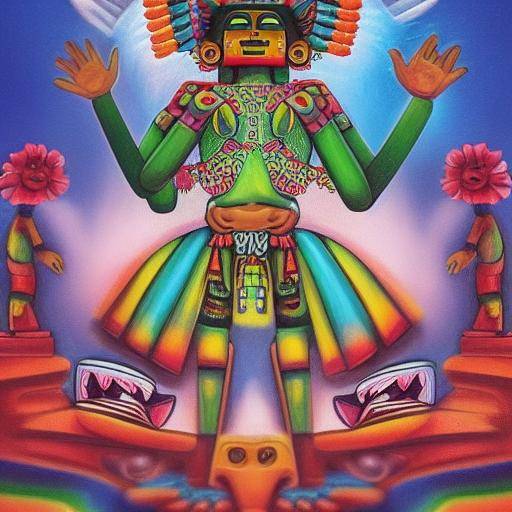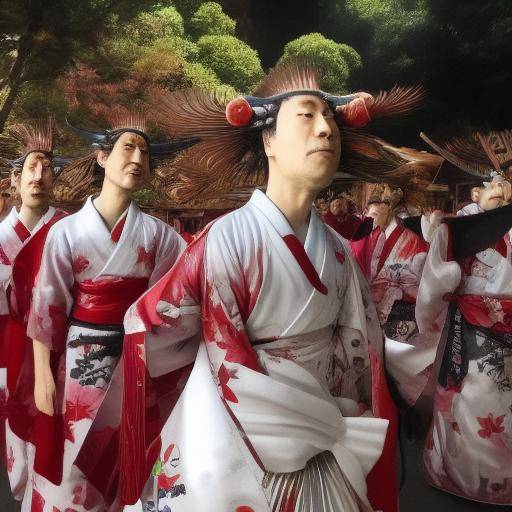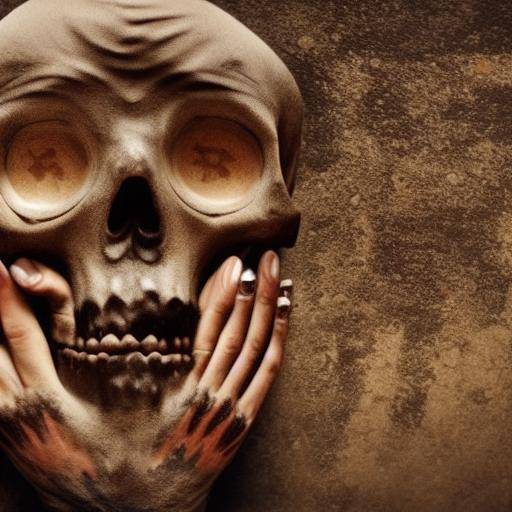
Introduction
The worship of death and rebirth has been a fundamental part of many ancient cultures. In Aztec mythology, Mictlantecuhtli is venerated as the master of the underworld, being a key figure in the understanding of life, death and rebirth. In this article, we will explore the history and importance of Mictlantecuhtli, as well as its relevance in understanding death, skeletons and rebirth. Join us on this journey through the beliefs and legends that have endured over time.
History and Background
Mictlantecuhtli, whose name means "Mictlán lord" or "place of the dead", is a central deity in the Aztec cosmogony. It is represented as a skeleton with brazen bones and a jaw unscrewed, personifying death and the underworld. The Aztecs believed that the fate of the deceased was to go to Mictlán, the kingdom governed by Mictlantecuhtli and his wife Mictecacíhuatl.
The worship of Mictlantecuhtli was fundamental in the festivities related to death, especially in the month of Miccailhuitontli, when the deceased were honored. This veneration reflected the belief in the eternal cycle of life, death and rebirth, intrinsic aspects of the Aztec worldview.
Deep analysis
The importance of Mictlantecuhtli transcended the mere conception of death. The Aztecs believed in the duality of existence, where death intertwined with rebirth. In this sense, Mictlantecuhtli was the guardian of this cycle of continuity, ensuring that the deceased went through the underworld to reborn in the fertility of the earth.
This understanding of death as an integral part of the life cycle gives us a deeper view of the Aztec cosmovision, where death was not the ultimate end, but a transition period towards a constant renewal.
Comprehensive review
The figure of Mictlantecuhtli invites us to reflect on the very nature of death, skeletons and rebirth. Its influence transcends old beliefs, as it allows us to reflect on the way we conceive these issues today.
In exploring the mythology of Mictlantecuhtli, there is a wider understanding of death as an intrinsic part of human experience, as well as the notion of rebirth as a continuous process in everyday life.
Comparative analysis
The vision of death, skeletons and rebirth in Aztec mythology can be compared to other beliefs and philosophies. While for the Aztecs, death was not the ultimate end, but a transition to a new form of existence, in other cultures these concepts can vary significantly.
However, the common denominator is the conception of death as an intrinsic phenomenon to human condition, and rebirth as a process inherent to the very nature of life.
Practical Tips and Useful Tips
- Honor the memory of loved ones: Take advantage of festivities such as the Day of the Dead to remember and celebrate the lives of those who are no longer physically present.
- Connect with nature: Reflects on the cycle of life, death and rebirth manifested in nature, which can provide comfort and understanding.
- Practice acceptance of death as part of the life cycle: Understanding that death is not the end, but a transformation into a new state of existence.
Conclusion
In conclusion, Mictlantecuhtli, the lord of the underworld, invites us to reflect on the very nature of death, skeletons and rebirth. Through his mythology, we can appreciate not only Aztec beliefs, but also a deeper understanding of the human condition and the eternal cycle of life. In exploring these themes, we connect with a fundamental part of our existence, finding comfort and renewal in understanding that death is only the beginning of a new life cycle.
Frequently asked questions
**1. What is the importance of the Mictlantecuhtli figure in Aztec mythology?**Mictlantecuhtli represents death and rebirth in Aztec mythology, being fundamental in understanding the cycle of life, death and rebirth.
**2. How did the Aztecs celebrate the death-related holiday?**The Aztecs celebrated festivities like the Miccailhuitontli to honor the deceased and recognize the eternal cycle of life.
**3. What lessons can we learn from Mictlantecuhtli mythology today?**The mythology of Mictlantecuhtli invites us to reflect on the very nature of death, skeletons and rebirth, offering us a deeper understanding of the human condition.
**4. How can we apply the concepts of death and rebirth in our daily lives?**We can reflect on the life cycle, death and rebirth present in nature, finding comfort and renewal in the understanding that death is only part of a continuous life cycle.
**5. What is the relevance of death and rebirth in different cultures?**Death and rebirth are universal themes that transcend cultural barriers, being an integral part of the human condition in various manifestations and beliefs.
**6. How can we honor the memory of our loved ones according to Mictlantecuhtli mythology?**Taking advantage of festivities such as the Day of the Dead to remember and celebrate the lives of those who are no longer physically present, connecting with nature and practising the acceptance of death as part of the life cycle.
In short, Mictlantecuhtli, the master of the underworld, as a central figure in the Aztec mythology, gives us a wider look on death, skeletons and rebirth, themes that transcend old beliefs to offer us relevant lessons and reflections in our time.
With its legacy, it reminds us that death is only a transition in the life cycle, and that rebirth is the eternal promise of a new beginning.
Join us on this journey through Aztec mythology and its relevance in understanding death and rebirth!



